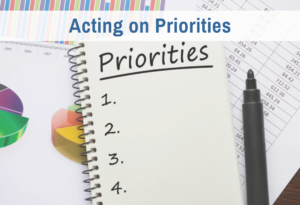I often get asked how to think on your feet. For example, suppose you are in a meeting, and your boss suddenly turns to you and asks for your opinion. How do you come up with a quick answer? You can’t stop to “think on paper” in that situation.
First, I want to point out that most of what we call “thinking on your feet” is actually “remembering on your feet.” Succinct, essentialized answers are rarely entirely spontaneous. If you know in advance that you will be asked questions (after a presentation or at an interview, for example), it’s crucial to prepare for them in advance. Make a list of questions you might get and figure out your answers by sitting at your desk and thinking on paper. This gives you the time and quiet to think in depth. Then you can simply draw on that past thinking when you’re asked the question on the spot. And you look very sharp in the process!
That said, we all get into situations where we’re asked questions and don’t know the answers off the top of our heads. What do you do then? You can’t just will yourself to answer — that’s a prescription for going blank. Sometimes you can put off giving an answer by promising to get back to the questioner with your thoughts.
Thinking aloud with an audience
But sometimes you need to say something right then. In this situation, I suggest you turn the conversation into “thinking aloud.” Do this deliberately. Say something like, “That’s a good question. Let me think aloud here to see if I can work out an answer.”
When you give that preamble, you warn the other person that they shouldn’t expect a polished, succinct answer. You get tacit permission to ramble a bit as you follow your train of thought, which is what you need to do. You balance your need to do some thinking with the listener’s need to hear your answer right now.
“Thinking aloud” has the same basic rule as “thinking on paper.” Use full sentences! That helps you think step by step. And since you have an audience, make each sentence as intelligible to the other person as possible. Your thinking aloud may turn into a discussion as they chime in with helpful information or answers to questions you pose in your thinking.
As soon as you have an answer, switch from “thinking aloud” to summing up: Deliberately bring the conversation back to the question and your answer. Say something like, “Okay, now I have an answer to your question…” Then state your answer as succinctly as possible.
Alternately, if you find that you are raising a lot of issues and there isn’t going to be a quick answer, you could sum up with something like, “Well, you see that there are too many issues here, and I’m not going to get an answer off the top of my head. I think I need some time to look at the issues I’ve just raised so I can give you a responsible answer.”
Why this works
By warning them that you are thinking aloud, then deliberately summing up your answer, you can maintain a professional demeanor even when you’re put on the spot.
Next time you are impressed by someone “thinking on their feet,” pay careful attention to whether they are doing new, fresh thinking aloud — or are cashing in on previous thinking they’ve done. Either way, you can learn something about how to capitalize on your own thinking prowess when you need to “think on your feet.”








0 Comments